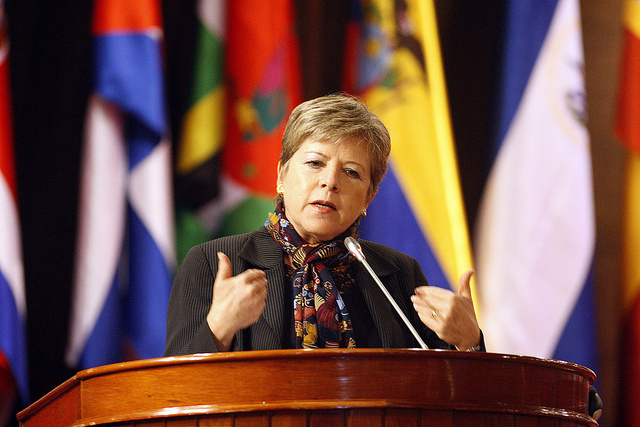Executive Secretary Highlighted the Importance of Improving Relations between Latin America and China
Work area(s)
The official referred to the need for a structural change in investment and productivity.

(22 August 2013) Over the past decade, China has become a key partner for Latin America and the Caribbean. Trade between the region and the Asian country increased 22 fold between 2000 and 2012, albeit with a deficit for Latin American countries.
Speaking at the opening of the seminar Doing business with China: the Latin American experience, at the Santiago headquarters, the Executive Secretary of the Economic Commission for Latin America and the Caribbean (ECLAC), Alicia Bárcena, said "It is important to open a debate on how to improve the quality of relations between Latin America and China".
At the meeting, which was also attended by Yang Wanming, Chinese Ambassador, Luis Enrique Berrizbeitía, Executive Vice-President of CAF, and Charles Shapiro, President of the Institute of the Americas, Ms. Bárcena reiterated China's importance in the world context, as it is the largest exporter of goods (11.2% of the worldwide total) the second manufacturing producer (19.8% of the total), number two recipient of FDI (9% of totals) and the third largest foreign investor (6% of the total).
Ms. Bárcena pointed out that Latin America and the Caribbean has significant assets for its trade relations with China, such as improved macroeconomic indicators, reductions in poverty and unemployment, a growing middle class and its endowment in natural resources.
However, there is significant asymmetry between the region's trade and investment flows with China. According to Ms. Bárcena "In 2011, Latin America and the Caribbean's share of world trade was close to, but remained below, levels achieved by Asia in 1985".
Such asymmetries can also be seen in the investment rate in Latin America and the Caribbean (22.9% of GDP), compared to over 40% of GDP in developing Asian countries. In addition, 2011 saw developing Asia export 3.3 times as many medium- and high-technology goods as South America.
In terms of investment, Latin American and Caribbean exports to China are dominated by raw materials, while China's imports to the region are mainly manufactures (especially high-technology products).
For Latin American and Caribbean countries, China's economic growth, urbanization and burgeoning middle class in the next few decades may trigger high demand for fuel, minerals and foodstuffs. This represents an opportunity to incorporate value and technology into natural resources.
According to Ms. Bárcena, despite the limitations, Latin American trade with China has been positive for the region, as it has boosted exports and growth, reduced exposure to less dynamic industrialized markets, pushed up commodity prices and increased the availability of low-cost Chinese manufactures.
However, there have been costs, such as reprimarization, caused by the recovery in the primary sectors of the region's economies in recent years.
For Ms. Bárcena, the greatest challenge is achieving structural change in which investment and productivity are increased using more technological innovation and productive chains: "The main challenge for Latin America and the Caribbean is to transform and diversify the export pattern to reduce the dependency on raw materials".
She added that achieving this aim would require making use of South-South trade and investment opportunities, as well as continuing to forge closer links between Latin America and the Caribbean and Asia-Pacific.
Against this backdrop, she said that China was implementing structural change from an investment-intensive economy to one based on consumption and internal demand.
On 21 August, ECLAC also hosted the academic seminar Trade relations between Latin America and Asia-Pacific: challenges and opportunities, organized by the Latin America - Asia Pacific Observatory, as a joint initiative of the Latin American Integration Association (LAIA) and CAF-Development Bank of Latin America.
The seminar included a forum for Asian and Latin American academics and experts to analyse the growing economic ties between Latin America and Asia-Pacific.
For Osvaldo Rosales, Director of the ECLAC International Trade and Integration Division, Latin America must closely monitor Asia-Pacific's trade agreements and be much more proactive in terms of cooperation with the region's countries.
The meeting also afforded an opportunity to further biregional relations, and culminated with an academic forum with the main aim of connecting specialized institutions and academics from the two regions, with a view to increasing efforts to encourage dialogue.
The forum will have its own section on the website of the Latin America - Asia Pacific Observatory, which will feature the names of participating institutions and academics.
Any queries should be sent to the ECLAC Public Information and Web Services Section.
E-mail: prensa@cepal.org; Telephone: (56 2) 2210 2040.
Follow us on: Twitter, Facebook, Flickr and YouTube.
Country(ies)
- Latin America and the Caribbean
-
China
Contact
Public Information Unit
- prensa@cepal.org
- (56 2) 2210 2040
